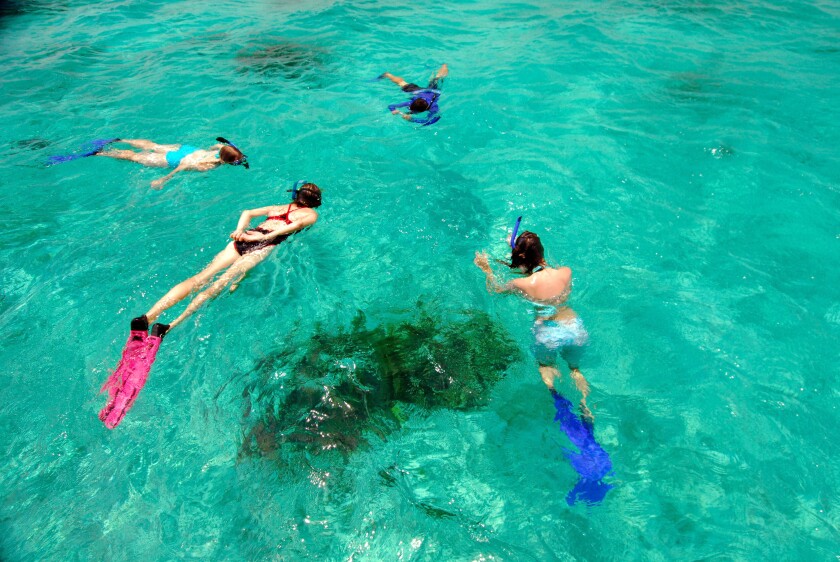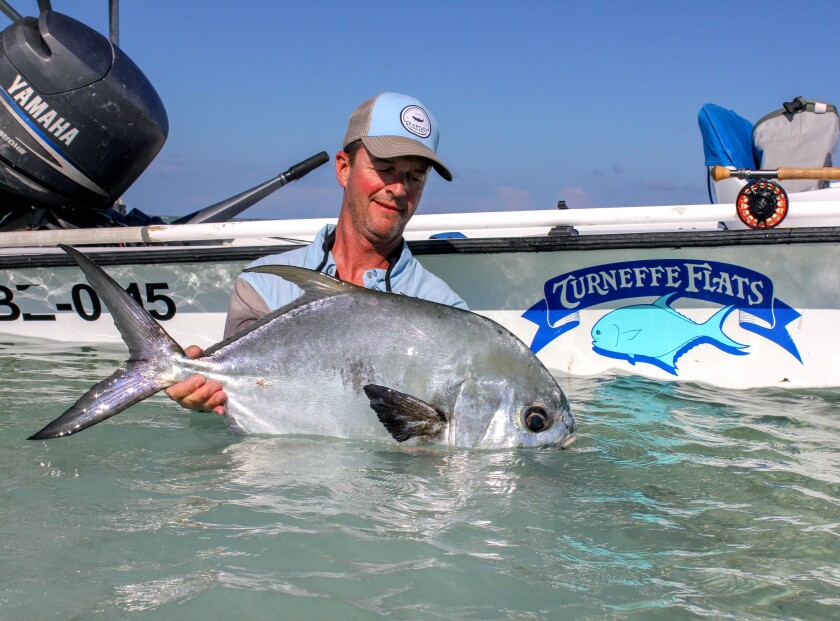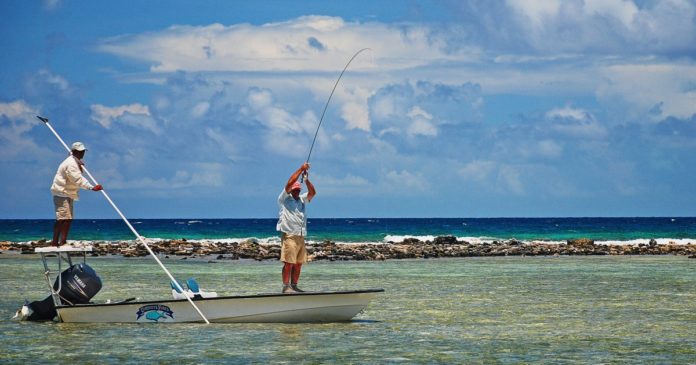For some, the notion of an isolated, utterly private Caribbean atoll may conjure up fantasies of tropical indolence — chaise lounges on a white-sand beach, umbrella drinks and perhaps a paperback.
There are chaise lounges and umbrella drinks available at Turneffe Flats. But most days the chairs are empty, as visitors come to explore the wonders of the most biologically diverse coral atoll in the Western Hemisphere by fly-fishing, scuba diving and snorkeling.
Turneffe Flats sits on Turneffe Atoll, a 300-square-mile series of hundreds of palm-fringed islands, endless mangroves, clear lagoons, and unbroken reefs — the very picture of pristine Caribbean beauty. It’s roughly 30 miles east of Belize City and is part of the Mesoamerican Reef System, the second-longest barrier reef in the world, stretching 600 miles from Mexico to Honduras. According to Oceanic Society, the habitat here is home to more than 500 fish species and 65 stony corals, as well as manatees, saltwater crocodiles and many other animals that may be encountered during a day’s adventures.
Turneffe Flats is the sole occupant of an island in Turneffe Atoll off Belize. It offers fly-fishing, scuba diving and snorkeling.
(Craig Hayes / Turneffe Flats)
Craig Hayes, an emergency room doctor from South Dakota, helped establish Turneffe Flats in the early 1980s with his wife, Karen.
“I’d started visiting an island named Caye Caulker in the late ’70s and had heard about this spot called Turneffe Atoll from local fishermen,” he recalled. “You had to cross some blue water to get there; the weather had to be right. We tried several times to go and eventually made it. We stayed in a lobster fishing shack.”
One of the fishermen he knew had a brother named Juni Marin, who had leased a piece of property on the atoll from the government. Around the same time, Sports Illustrated had run a story about bonefishing around Turneffe. So, Hayes, said, “We asked Juni if there were any bonefish around the property.
“ ‘Oh yeah,’ he said. And he took us over to a spot called Grassy Caye, and we saw huge schools of bonefish. After that, we made a deal and formed a company. It was 1981.” Four years later, two bare-bones cabins were ready to welcome Turneffe Flats’ first angling guests.
Hayes’ background as a physician and lodge owner has proved fortunate. Last spring and summer, he worked closely with the Belizean prime minister’s office to draft coronavirus protocols for tourists, and the country’s pandemic travel response has been widely emulated. To enter Belize, visitors must present one of the following: a negative PCR test within 96 hours of travel, a negative rapid antigen test within 48 hours of travel, or a vaccination card documenting vaccination has been completed at least two weeks before arrival. All visitors must stay at a “Gold Standard”-certified resort; Turneffe Flats was the first property to receive the designation.

There is excellent snorkeling around Turneffe Atoll, which is part of the Mesoamerican Reef System. Turneffe Flats offers an Adventure Atoll program that includes snorkeling, kayak and land tours to help visitors gain a better understanding of the region’s ecosystems.
(Turneffe Flats)
“The Belize International Airport reopened on Oct. 1,” Hayes said. “We reopened shortly thereafter. Booking was slow initially, but the last few weeks in March we’ve been at full occupancy.”
It was Turneffe’s excellent flats fishing that first put it on the map.
“We send many anglers to Turneffe Flats, and plenty that may be new to saltwater fly-fishing,” said Dylan Rose, saltwater destination manager at Fly Water Travel, a fishing travel agency based in Ashland, Ore. “Whether you prefer to wade or fish from a skiff, the bonefish are plentiful. It also helps that all the guides speak English, which is not always the case at other Caribbean locations.”
More-seasoned anglers, Rose said, visit Turneffe to focus on another game fish called permit.
“We have many guests who catch their first permit at Turneffe,” he said. “Achieving a grand slam — catching a bonefish, permit and tarpon on the same day — is also possible in season. This is a momentous occasion for saltwater fly anglers.” (The migratory tarpon, which arrive in late spring, can eclipse 6 feet and 100 pounds.)
Most fishing is done from a flats skiff. The guide will pole the skiff along on the shallow flats from a platform at the back of the boat, while the angler stands ready to cast from the front. When the guide spots fish, he will call out their location according to the face of a clock (12 o’clock indicating directly off the bow) and distance. Many anglers, caught up in the excitement of facing down their first bonefish or permit, will muff their first few casts. But the guides at Turneffe are calm and patient, and the fish plentiful enough that future opportunities will materialize.
(An added benefit of Turneffe is that bonefish are often present on the flats right in front of the lodge, so anglers who can’t get enough — like yours truly — can pursue them in the hours before breakfast and after the day’s guided fishing.)
“I promised my nephew a flats fishing trip for his college graduation gift,” said Reid Reynolds, a dedicated trout angler from Denver. “It took 18 years, but we finally did it. He recommended Turneffe. I’d never fished for bonefish before and found the ecosystem of the flats amazing. I managed to catch some, but we spent most of our time chasing permit, as my nephew really wanted to catch one.”
“Permit have been my Moby Dick for years,” said his nephew, Eric Shoemaker of Portland, Ore. “I’ve been obsessed. I had 12 good shots at Turneffe. … But I came up empty.”
Belize is celebrated for its scuba diving, and Turneffe is convenient to some of the region’s most coveted dive sites. Over the course of a week, diving guests can anticipate 18 dives, including (weather permitting) a trip to the Blue Hole, a giant marine sinkhole with huge stalactites that reaches a depth of more than 400 feet and is renowned for its clear waters and cave formations. “Divers have heard of the Blue Hole, but I think there are even better sites that we visit,” said Rubin Navidad, a dive instructor at Turneffe Flats. One is the Elbow, at the southern end of the atoll. “If the currents are right, we might see huge schools of horse-eye jacks, snappers, kingfish, tuna,” Navidad continued. “There’s so much forage about, the predators are in hunting mode. It’s a very action-packed dive.”
Divers at Turneffe have access to 65 dive sites. Groups are small, and outings are highly individualized. A weekly night dive is also available, a great chance to encounter octopuses and eels.

An angler prepares to release a permit, a sought-after game fish in the waters of Turneffe Atoll along with the plentiful bonefish and the migratory tarpon.
(Jeff Currier / Turneffe Flats)
For those who prefer to experience the atoll’s natural wonders from the surface, Turneffe Flats offers the Adventure Atoll program, which combines snorkeling, kayak and land tours to gain a better understanding of the region’s ecosystems. With resident naturalist Abel Coe, guests might spend the morning snorkeling a reef to learn about the marine life there and an afternoon paddling the mangroves looking for manatee (25 to 30 live there) and birds. “I also like to take guests on a night walk near the lodge, looking for creepy-crawlies,” Coe said. “We usually can find saltwater-crocodile nesting sites, boa constrictors, scorpions and tarantulas. Some guests are a little scared at first, but I make it safe and fun.” (Saltwater crocodiles — technically, American crocodiles — can reach over 15 feet in length but are generally not aggressive toward humans.)
“Abel is incredibly knowledgeable about the life cycle of the reef and its species,” said Peter Winch, a San Francisco-based naturalist and trip leader with Oceanic Society, who was hosting guests during my visit to Turneffe last March. “You come away with the sense that he and his cohorts are truly devoted to protecting the resource. I was very encouraged by the condition of the reefs around Turneffe.”
That the environs around Turneffe remain pristine is not a matter of coincidence. Hayes, along with other conservationists from Belize and abroad, formed the Turneffe Atoll Trust in 2002 to promote the atoll’s conservation efforts while advancing scientific understanding and educating the public about the ecological and economic value of sustainably managing tropical marine habitats.
In 2012, thanks to the trust’s advocacy, the Turneffe Atoll Marine Reserve was established — providing a management structure for the atoll’s fisheries and its development.
The rustic cabins of Turneffe Flats’ first incarnation have come a long way. Eight handsome double-occupancy beachside cabanas feature two queen beds, private bath and air conditioning, with a covered deck overlooking the reef. Three villas (two 3-bedroom, one 2-bedroom) with common areas are well-suited for larger groups and families. Guests can enjoy a dip in the infinity pool — perhaps with a cold Belikin beer — while watching anglers cast to bonefish. Breakfast and dinner are served in the lodge building, which also houses a comfortable bar; lunches are usually enjoyed on the water. Dinner entrees range from balsamic short ribs to coconut-crusted snapper, and many cocktails feature Belizean rum.
Innovations in sustainability at Turneffe Flats include a 250,000-gallon rainwater collection and storage system, a state-of-the-art gray-water recycling system, an aggressive composting and recycling program, and the most recent addition — an off-grid solar system that generates 80 percent of the resort’s electricity.
In a time where many of the world’s great wild places are experiencing decline, the environs of Turneffe Atoll seem to be improving — a sign, perhaps, that humans can make a positive difference while still having fun.
If you go
Turneffe Flats: (888) 512-8812, tflats.com
A full-service eco lodge on an isolated atoll 30 miles east of Belize City, in the Caribbean Sea. Guests come to fly-fish, scuba and participate in eco-tourism activities such as snorkeling, kayaking and wildlife viewing.
Rates: Following rates are for seven-night/six-day packages, based on double occupancy, through Dec 22. Fly-fishing: $4,090; diving $2,990; atoll adventure $2,590. Guides, lodging, meals and use of resort amenities included. Flights, bar tab, gratuities and Belizean taxes not included. Shorter stays and mixed packages also available.
Booking: Trips can be booked through outfitters including Fly Water Travel, (800) 552-2729, flywatertravel.com; and Gil’s Fly Fishing International, (416) 613-8573, flyfishinginternational.com. Rates are the same as resort’s.
Santella is a freelance writer for The Washington Post.
Copyright: Special To The Washington Post.
Credit: Source link































